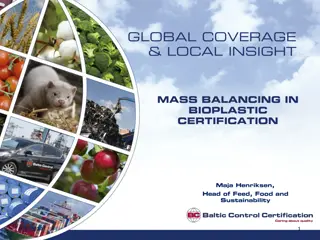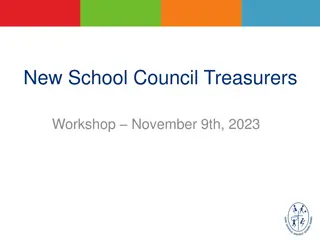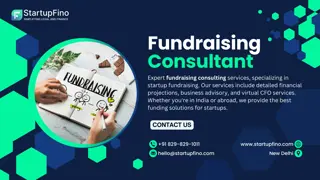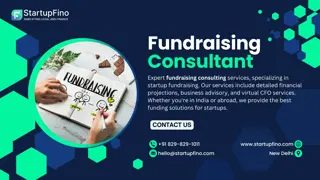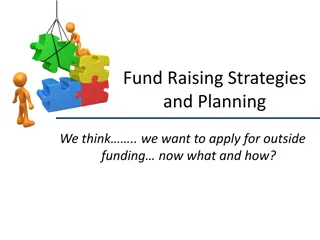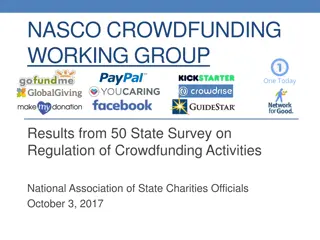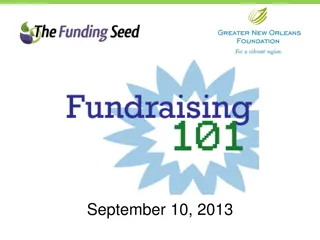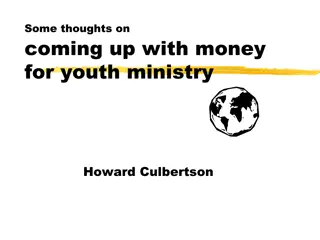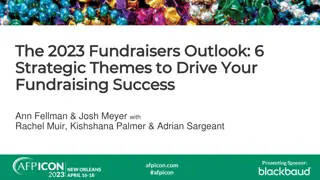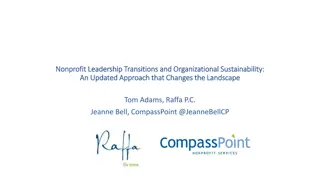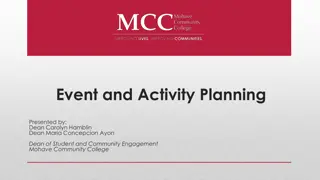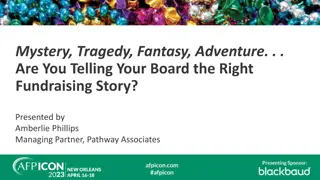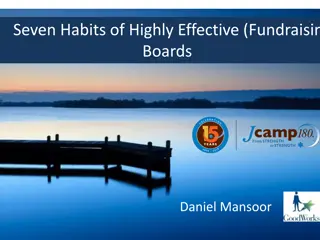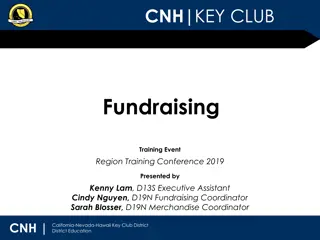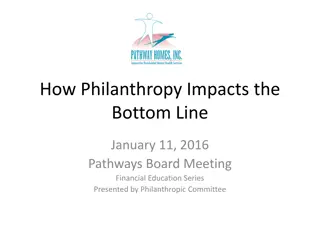Financial Management and Fundraising for Organizational Sustainability
Explore the importance of financial management and fundraising in maintaining organizational sustainability and resilience. Dive into topics like budgeting, operations, and accountability to understand how financial sustainability contributes to overall organizational success. Discover insights on organizational resilience in the face of internal and external challenges.
Download Presentation

Please find below an Image/Link to download the presentation.
The content on the website is provided AS IS for your information and personal use only. It may not be sold, licensed, or shared on other websites without obtaining consent from the author.If you encounter any issues during the download, it is possible that the publisher has removed the file from their server.
You are allowed to download the files provided on this website for personal or commercial use, subject to the condition that they are used lawfully. All files are the property of their respective owners.
The content on the website is provided AS IS for your information and personal use only. It may not be sold, licensed, or shared on other websites without obtaining consent from the author.
E N D
Presentation Transcript
Finance for Non-financial Managers Sonja Stojanovi Gaji 30 January 2023
FOCUS FINANCIAL MANAGEMENT & FINANCIAL HEALTH LEADERSHIP IN OLD NORMAL IN THE CRISIS
4 Sonja Stojanovic Gajic 2006-2019 Director of Belgrade Centre for Security Policy (BCSP) and helped it transform from national NGO into the internationally recognized think tank on security policy Mixed job description: management and programme Self-educated manager - learned by doing it and leading an organisation through change process Assisted also the organisations in East Europe, Middle East and Latin America
BCSP budget over years in Euros The oldest organisation in the Western Balkans focussing on accountability of security institutions (police, military, intelligence .) since 1997 Among bigger ones in the region of South-East Europe mid-income country 2008. 2009. 2010. 2011. 2012. 2013. 2014. 340,337 378,649 374,574 411,637 404,632 522.805 667.694 2015. 2016. 2017. 2018. 2019. 2020. 2021. 589.659 446.000 509.878 471.285 417 636.111 700.000
How do you feel about finance management and fundraising?
INTRO SURVEY https://docs.google.com/for ms/d/e/1FAIpQLSdNiXbs3XZB PSzZQih34855dXeaKJ5sJU0ect KCj-GhBNBo-g/viewform
Financial Suistanability is just a componet of Organizational Sustainability Organizational sustainability is not strictly a financial consideration; Financial sustainability is only one of several factors contributing to a TT s overall sustainability and resilience;
The greater the extent of internal vulnerabilities, an organization is the more at risk in increasingly hostile external environments. Organizational Resilience 9
Pillars of Financial Management 1. Business and Financial Model 2. Budgeting (costing, revenues and operating reserves) 3. Budget monitoring - cashflows 4. Operations: division of labour, responsibility and reporting 5. Accountability, transparency and integrity
Difference between business and funding models
Business Model Funding Model Revenue generation what kind of sources? What is the proportion of different sources in the budget? What is duration/funding circles? The cost structure: % operational costs (rent, research, overhead ), partner costs Focus Value creation (unique) and delivery, cultivation of trust and reputation Research performed and communicated Raise, receive, account for, report on funds Activities All staff, Board, peer-reviewers Director, Financial Officer (+book-keeper, auditor), Board Project Officer or Researchers or specialized fundraising team Staff Goal Organisation is empowered to achieve its mission on a continuous basis cash in the bank, audit reports signed off, funders support maintained over time due to correct financial processes and management Key stakeholders Research community writ large, policymakers, private sector and third sector actors, donors, ordinary citizens Donors (individuals, companies, governments, philanthropic organisations)
Business Model Funding Model Organisation X conducts and disseminates original research on key public policy issues in Country Y. Organisation X derives 20% of its budget from subscriptions to its flagship publication; 30% from research contracts; and 50% from international sponsors. Example statement It receives financial support from: three sources, which enable it to employ the services of a team of professionals, including a high-level and widely cited and respected policy researcher. This funding model requires the full-time services of a book-keeper, the part-time services of a financial manager, and an external audit partner. The inputs of middle-management and the organisation s director are also required month-on-month to ensure steady revenue generation and correct financial reporting. The director of Organisation X is widely regarded too by the research community, and its Board is made up of individuals that leverage their positions to create new policy influence and funding opportunities.
Suistanability Matrix It is about finding the right mix for your organisation: Fits your mission Combination of sources and types of funding (not all eggs in one basket) Allows you to do your core work (long, reasonable costs) https://nonprofitquarterly.org/th e-matrix-map-a-powerful-tool- for-mission-focused-nonprofits/
The adaption to the external context is required to continue succeeding e.g. What are sources of money to be found? Policy environment: Is there demand for research? Thinking about the Implications on: human and other costs of running organisation: Research, Staff & Project Management, Communications, and Policy influence. in the project market (partnerships, brand communication, quality control, transparency and strategic orientation) in managing relationships with funders: balancing demands and interference (how to guarantee independence?)
The Transformation of BCSPs business and financial model to the context Years Context Business Model Capacities Funding Model 1997-2000 Authoritarian Closed Country under international Sanctions Activist NGO Ideas and activism of 2 founders supported by friendly CSOs No money, no trouble 2000-2006 Democratic Transition Golden Area of donors interest No competition NGO with focus on research Founders and external research associated All in 1 person admin/finance Projects from donors 2006-2012 Democratic Consolidation Increased national competition Transformation into Think Tank until 2010 2 members in the Finance Team + 1 all other admin Comms team Institutional Funding with smaller other projects Regional Leadership
The Transformation of BCSP Years Context Business Model Capacities Funding Model 2012- 2015 EU Integration and the EU as a main donor in town Peace Talks on Normalisation of Relations with Kosovo Dense regional and national competition Think Tank with Regional Focus Same Project writing for all research staff as project management is with researchers Advance financial procedures and organisational audit Phasing out institutional support 2015: no 2014: 10% 2012: 40% Policy Broker on Dialogues 2014 - 2019 State Capture Closing civic space and media freedoms Huge competition from other types of organisations (investigative journalists, fake NGOs) EU is the biggest and most cumbersome donor, bilateral donors retreat Think Tank focusing more on citizens and other democracy- defenders 2 person finance EU funding Income-generating activities Mixture EU different types International donors (govs and foundations) Income through consultancy work No gov funding Thinking of professionalization of project management & fundraising role
The context matters for funding opportunities POLICY ENVIRIONMENT: Is there demand for research and what is a competition? A lot of media interest in security topics, but on wrong topics. Democratisation agenda is almost dead on donor s agenda How to stay true to the mission? FUNDING ENVIRIONMENT: Is there money to be found? Foreign funding sources for civil society: the biggest is EU, but few cumbersome opportunities as it is very demanding for administration (co-funding demand, liquidity), Bilateral donors retreat from the Balkans except Kos & BiH. A number of small grants by individual foundations and embassies. De-legitimisation of foreign funded NGOs Government funding: The biggest donor at the local level non-transparent, funding technical & QUANGOs. Not any more independent oversight bodies (e.g. Anti-Corruption Agency, Ombudsperson) used to have transparent competition for NGO funding Private/corporate funding for our policy area is limited and dubious Increased opportunities for consultancy work and academic and international partnerships Crowd-funding for think tanks is a terra incognita
FUNDING MODEL Research Agenda Policy Influence Staff Fiscal Stability Allows to conduct relevant research? Allows to take advantage of policy windows? Covers operating costs Core/Institutional funding Grants/ Project Funding Corporate or Private Sector Funding Government funding Membership Crowd-funding Consultancy work (service and product sold commercially) Academic research funding Endowment
Revenues: Understanding the Options Gifts and Grants Here are some typical sources and pros and cons. Source Description Pros Cons Individuals Donations tend to be less tied to specific program outcomes, more untied revenues. Can provide ongoing revenue streams if repeat donors. Individuals can be cultivated over time for larger gifts. Building an individual donor base of repeat donors who give increasing amounts is a long term process that requires continuous communication. Corporations Tend to fund projects with high levels of visibility and marketing opportunities. Often ask for names to appear on publications, events etc. also smaller amounts for the most part. Fluctuate with corporate profits. Foundations Tend to fund innovative projects With a few exceptions fund the same organization for no more than a few years Government Fund larger scale projects or smaller short term one year projects, risk of politization Require a great deal of report detail. Restrictions on line items expenditures Change with each election National/ International Agencies Grants tend to be significant size and require significant capacity to manage Discontinue funding when region no longer of strategic interest. High reporting requirements
21 Funding Mix Types of Revenues 2015 REVENUES (EUR) 2016 82,9% 83,9% Grants (International Contributors) Grants (Domestic Contributors) 10,4% 2,8% 0,2% 9,2% Earned Income - Consultation Services (International Contributors) 5,3% 2,0% Earned Income - Consultation Services (Domestic Contributors) 0,2% 3% Other income (Reimbursement of maternity leave, etc)
Is this Sustainable Think Tanks Financing? more steady flow of secured income - reliability diverse funding sources, decreased dependence - diversification more unrestricted income (reserves) - flexibility ability to think and plan more long-term
Under which conditions are we getting funds? Relationship to mission: Does this source enhance or detract from your mission? Does it enhance or detract from your reputation? Acceptable conditions: Whatever administrative, contractual and/or programmatic conditions are attached to funds, they should enable the think tank to do their policy work to the best of their abilities. Independence: A basic condition of a good funding model is for it to guarantee that a think tank remains independent to govern itself and define its policy research agenda: deciding how to run the organisation, which issues to pursue, etc. Transparency: A growing concern related to funding models has to do with being able to track the origin of funds that think tanks receive and the main conditions attached to them. Visibility: Does this source have positive public relations or visibility benefits? What are the costs to our reputation and credibility? What are the costs and investments required in relation to benefits: Start-Up Costs: How difficult and costly is it to begin receiving income from this source? Continuing Costs: How difficult and costly is it to obtain this source of revenue (staff time to perform work or report, infrastructure investment, etc.) Organizational Capacity: Do you have the capacity (staff, infrastructure, financial, cultural) to develop and maintain this source?
Lesson: Make your organization s matrix for assessment of funding opportunities Dillema: Who should be in charge of fundraising: research or specialised person/team What if pizza shops were funded like non-profits? https://youtu.be/-gELZnORV4U
Lessons learned on budget structure Growth is not necessarily a good thing! Increased budget over years, but not operational budget same Partnerships are both an opportunity (for longer programme research and advocacy and defense against attacks) and challenge to manage (coordination costs and high burden on financial staff of coordinator, co-funding requirements) Description 2014 2015 BCBP SHARE 269 58% 510.096 87% PARTNERS SHARE 191 42% 75.087 13% Total EUR 460.000 585.183
A budget is your organizations strategy expressed in currency. Budget distribution 2014 1. Core organisational budget Salaries 23% Office costs 8% (11% with admin staff) 2. Program costs Capacity building 3% Comm/advertisement 1% Public opinion survey 2% Publications 7% Other activities 23% 3. Capacity-building and investment 4. Contingency 3. Partners 229.939 32% 1. Core budget 220.617 31% 2. Project activities without HR costs 258.865 37% Lesson: For balanced budget, you may will need the reserve or unrestricted funds!
What are the resources to be used to most effectively meet your mission and that your organization remains sustainable and accountable to its stakeholders? 1. Assemble a budget team (CEO, CFO finance manager, development-fundraising person, program managers) Create a budget calendar enough advance time for this process Prepare for budget process (set financial goals, reserves, data on spending for few years e.g. the types of costs donors do not want to support, kickoff mtg) Build the budget (budget expenses: direct to delivery of services e.g. program costs, shared expenses and overhead, fundraising costs ), Revenues and risk analysis less predictable (scenario planning for risks), secure Board approval (finance committee) Monitoring the budget 1. Budget-to-actual revenue and expenses program managers 2. Executive director budget-to-actual revenue and expenses for each program and organization-wide, balance sheet, year-end forecast, 3. Board same plus Dashboard (% against targets) 2. 3. 4. 5.
ORGANISATIONAL CAPACITY for sound financial management and accountability matters for your internal and external credibility, fundraising. Keeping track of income and expenses. Which are essential procedures/organizational budget, standardized coding costs and then different attribution (project, staffing ) Creating a sound finance team: roles and responsibilities. Know your targets for fundraising and reserves! How to be transparent? Lessons from Transparify https://www.transparify.org Check out and adjust templates to your context (demands by domestic legislation, foreign funders .) https://www.wallacefoundation.org/knowledge- center/resources-for-financial- management/pages/default.aspx MANGO Guide for Financial Management for Non-profits https://humentum.org/free-resources/guide/free- downloads?
Mistake of forgeting about Liquidity not just what an organization s revenues and expenses look like, but when they come and go an organization with a balanced (or even surplus) budget can still end up running out of cash healthy cash balance doesn t necessarily translate to cash fluidity. For instance, particularly in organizations that have multiple streams of funding for individual programs (where, as alluded to earlier, some money is restricted to certain activities), it is easy to lose track of the purposes for which each stream may be used. You may have enough money to run the program, but the money may end up being spent in ways other than what each funder requires. o the costs . Contracts with government entities pay for services only after the services are delivered, forcing the service-providing nonprofit to cover the initial outlay of cash Calendars of foundations vary If neither reserves nor credit are options in a cash crunch, nonprofits may be forced to resort to less appealing means of riding out the storm. approaching funders for accelerated or advanced payments delaying payment of certain noncritical vendors. a loan from a staff or board member, which could raise conflict-of-interest concerns. the worst-case scenario is delaying payroll for some or all staff https://www.wallacefoundation.org/knowledge-center/resources-for-financial- management/pages/cashflow.aspx
FINANCIAL MANAGEMENT AND LEADERSHIP DURING A CRISIS
Financial management in the crisis Increasingly unpredictable revenue Foundations recive the income from stock market Donors are under the pressure to re-direct funding to COVID-19 assistance and research Expectation of funding to decrease E.g. almost half of members (48%) of BOND, the leading UK network of INGOs leading on international development do not see themselves operaing in 2 years time Restrictive and polarised envirionment Foreign agent argument
Group 1 - Good practice of costing for project (how do you get money for indirect costs ) Group 2 - List the possible ways to earn income and make reserve: sources, benefits, downfalls, best practices Group Work Group 3 - Create demand and donor for unpopular topic or for which there is no call
Recommended reading https://nonprofitquarterly.org/pizza-and-a-laugh-a-reminder-about-your- nonprofit-financial-stress-level/ On Think Tanks s section devoted to funding for think tanks: www.onthinktanks.org/themes/funding-and-supporting-think-tanks Nine webinars on sustainability https://onthinktanks.org/resources/nine- webinars-on-sustainability-for-think-tanks/ (recommend How to create a smart project budget for a think tank & Evidence-informed Fundraising Strategy) Politics & Ideas has a collection of articles that are based on a series of online course on funding models, which were delivered to dozens of think tanks in 2015, 2016 and 2017: http://politicsandideas.org/tag/funding-model
Recommended reading on nonprofit finance and crisis NPQ (2010) The Four Horsemen of Nonprofit Finance Apocalypse https://nonprofitquarterly.org/the-four-horsemen-of-the-nonprofit-financial-apocalypse NPQ (2020) Sustanability to Survavibility: 5 Nonprofit Must-Do s in the Time of COVID https://nonprofitquarterly.org/sustainability-to-survivability-nonprofit-finance-must-dos- in-the-time-of-covid Cash Flow Nonprofit Model https://nonprofitquarterly.org/cash-flow-nonprofit-business- model-question-whats-whens Bond 4 ways funders are supporting NGOs https://www.bond.org.uk/news/2020/04/4- ways-funders-are-supporting-ngos-and-responding-to-coronavirus
How to manage finances in nonprofits https://www.wallacefoundation.org/knowledge-center/financial-management-for- nonprofits/pages/default.aspx MANGO Guide for Financial Management for Non-profits https://humentum.org/free-resources/guide/free-downloads? Executive directors guide to financial leadership https://nonprofitquarterly.org/executive-directors-guide-financial-leadership-2 Financial stress forecasting tool https://onthinktanks.org/resources/think-tanks- stress-test-a-forecasting-tool/ Transparify - transparency of funding https://www.transparify.org/our-methodology
Stay in touch https://ucl.academia.edu/SonjaStojanovicGajic sonja.stojanovic.gajic@outlook.com
SCHOOL for THINKTANKERS www.ott.school





